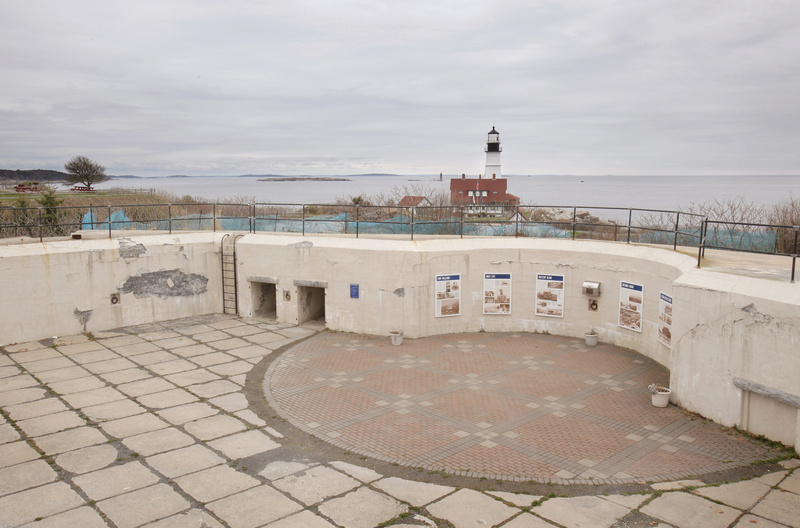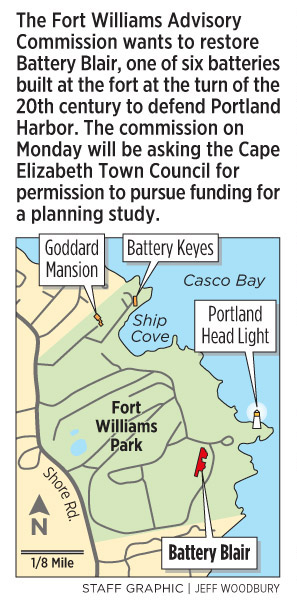CAPE ELIZABETH — In the 1970s, a sewer project helped transform Fort Williams into a park. Soil dug from another part of town was used to build the roads and playing fields, fill the foundations of demolished buildings and cover the gun batteries along the shoreline.
Two batteries behind Portland Head Light were buried up to their parapets, but part of one – Battery Blair, built in 1903 – was left exposed. Now, an effort is under way to determine the feasibility of further uncovering and restoring it.
The town’s Fort Williams Advisory Commission and the independent Fort Williams Charitable Foundation want a planning study. It would determine the battery’s condition, the cost and scope of a restoration, the kinds of informational displays that would be developed and possible funding plans.
The commission will seek Town Council approval Monday to pursue private funding for the study, which is expected to cost $37,000.
The foundation would run the fundraising.
The concept is still in its early stages, and any project would be long term, said Lois Carlson, acting president of the foundation.
“We’re beginning to think about historic preservation, and the batteries are key to this,” Carlson said. “Who knows? Once one is brought back to life again, perhaps a second one might follow.”
Battery Blair, named after Francis P. Blair Jr., a veteran of the Civil and Mexican wars, occupies a prominent spot in the town-owned park. Visitors pass it when they go from the main parking lot to Portland Head Light.
The exposed part of the battery now looks like an oddly shaped, one-story concrete wall topped with metal railings. What visitors see is the north gun emplacement, which once held a 12-inch-diameter gun capable of firing projectiles 10 miles.
Another level, with spaces for tools, ammunition, generators and latrines, is below ground. Most of the south gun emplacement is beneath a grassy slope, but it’s possible to walk much of the length of the original structure on top of the parapet.
Lori and Mark Chesebro, artists from New Harbor, visited the fort this week after dropping off work at a gallery in Portland. They found the concept of uncovering more of the battery intriguing.
“I can visualize it. It would be fascinating,” Mark Chesebro said.
Fort Williams was built as a part of a defense system for Portland Harbor, which could be used as an anchorage for a Navy fleet defending against a naval attack, said Kenneth E. Thompson Jr., a Portland historian and a non-voting member of the Battery Blair Study Subcommittee.
The guns at Battery Blair were fired only for practice.
Three companies of 80 to 100 men were assigned to Battery Blair before World War I, and their numbers were beefed up after the war began, Thompson said. But when it became clear that Germany didn’t have the surface navy to reach the Eastern Seaboard, many of the soldiers were transferred to Europe, he said.
During World War II, the number of personnel was again increased, then cut back when it again became clear that Germany’s surface navy was not a threat, Thompson said.
The guns were scrapped in 1944-45, he said. The battery was obsolete because the guns were vulnerable to aerial bombardment and the guns aboard ships could fire longer distances.
Staff Writer Ann S. Kim can be contacted at 791-6383 or at:
akim@pressherald.com
Send questions/comments to the editors.




Success. Please wait for the page to reload. If the page does not reload within 5 seconds, please refresh the page.
Enter your email and password to access comments.
Hi, to comment on stories you must . This profile is in addition to your subscription and website login.
Already have a commenting profile? .
Invalid username/password.
Please check your email to confirm and complete your registration.
Only subscribers are eligible to post comments. Please subscribe or login first for digital access. Here’s why.
Use the form below to reset your password. When you've submitted your account email, we will send an email with a reset code.